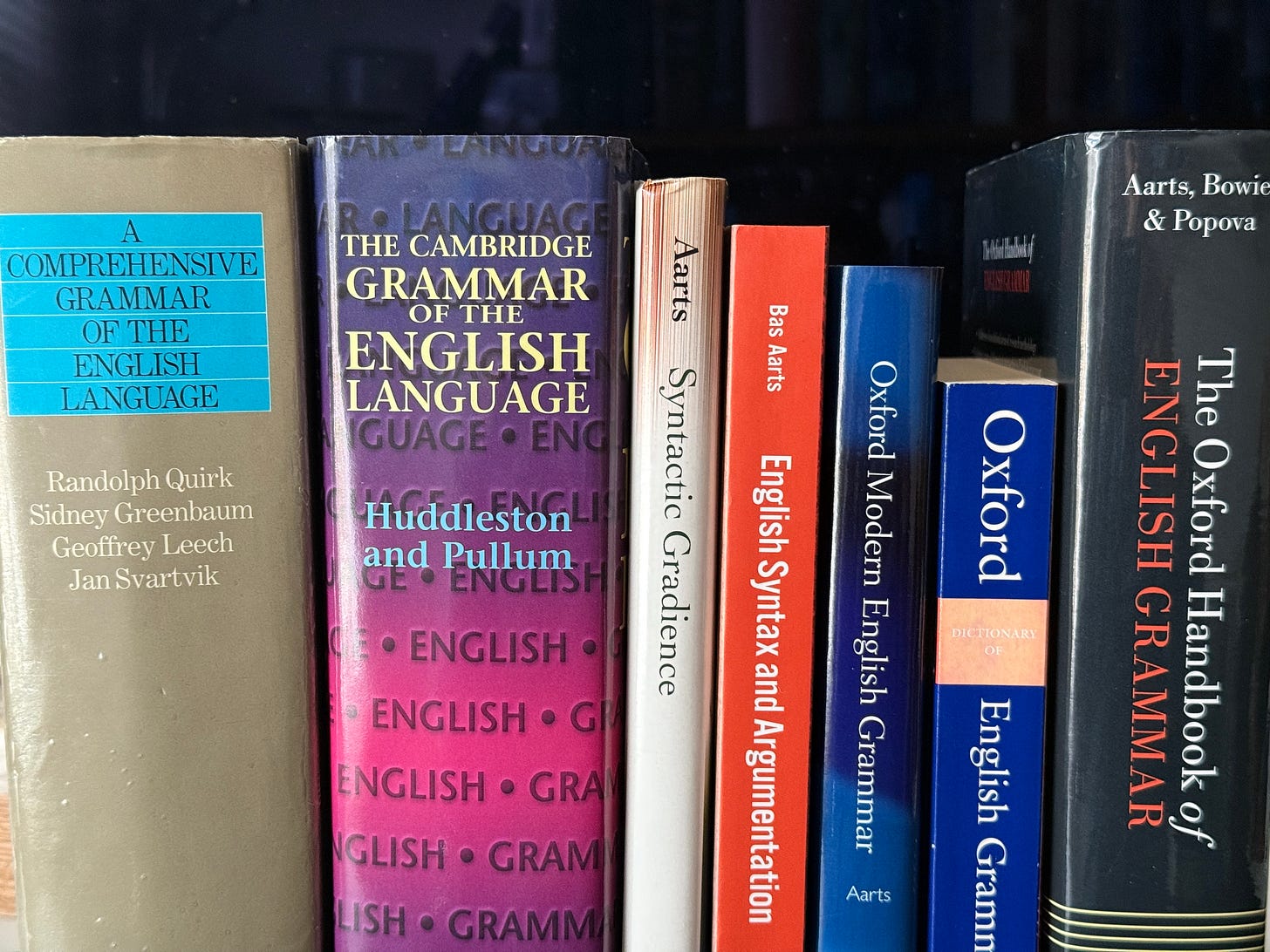English Grammar
A new Substack intended for a general audience that has some knowledge of grammar already
On this Substack I will post on English grammar in general, but with a special focus on sentence analysis. It is intended for those who know some grammar already.
It is not intended for learners of English or for those looking to improve their English. There are plenty of alternative resources for you if you are looking for learning support.
Sentence analysis is traditionally called parsing.
I will regularly discuss the structure of phrases and clauses, using the framework of my Oxford Modern English Grammar (Oxford University Press, 2011) which is influenced by two major reference grammars of English: the Comprehensive Grammar of the English Language by Randolph Quirk, Sidney Greenbaum, Geoffrey Leech and Jan Svartvik (Longman, 1985) and the Cambridge Grammar of the English Language by Rodney Huddleston and Geoffrey Pullum et al. (Cambridge University Press, 2002).
There are other grammar models around, and where appropriate I will mention or discuss them. What’s important is that you need to be prepared to give up — or at least reconsider — (some of) the ideas about grammar that you may have learnt about at a different time.
I will discuss the grammatical points of interest of the chosen sentences, and we will see that sometimes more than one analysis is possible. Grammar poses lots of interesting structural puzzles and figuring out how to solve those puzzles is great fun. As we will see, many puzzles allow for different analyses, and sometimes it’s not obvious which solution is best.
“But this Substack is nerdy, esoteric and niche!”, I hear you say. For sure, it is, but that’s what I’m passionate about, so I won’t apologise for it, as some writers on grammar do.
Different readers will have different backgrounds in the study of grammar. As I said above, I will assume that you have a basic knowledge of grammar already. However, I will explain some of the fundamental notions of grammar nonetheless, as I go along, so if you hear something that you already know, just bear with me.
It’s important to be aware of the fact that you may have learned a different kind of grammar from the grammar that I'm presenting on this Substack. When I talk about a particular way of analysing a structure, you may have to sometimes grammatically suspend your disbelief . One of the joys of grammar is that there are often different ways of looking at the same construction.
As we will see in just about every posting, at the heart of my discussions is a distinction between grammatical form and grammatical function.
The former refers to the building blocks of language, namely word classes (nouns, verbs, adjectives, etc.), phrases (noun phrase, adjective phrase, verb phrase, etc.) and clauses (main clause, subordinate clause, etc.), and the way in which these units are structured internally.
By contrast, grammatical functions are grammatical relations: they indicate how a particular grammatical unit behaves (functions) in a sentence vis-à-vis other units, namely as Subject, Direct Object, Adjunct, etc. (Notice that I’m spelling grammatical function labels with capital letters.)
If you want to brush up on your grammar, so as to be able to follow this Substack, take a look at my Oxford Modern English Grammar, or its shorter version English Grammar: All You Need to Know. I created a FutureLearn course based on the latter.
For help with grammar terminology, have a look at the Oxford Dictionary of English Grammar (second edition, Oxford University Press, 2014), which I co-wrote with Edmund Weiner and Sylvia Chalker.
If you are a teacher in England who teaches the National Curriculum (NC), please note that the grammar framework I use on this Substack is different from the grammar used on the NC.
Have a look at my WordPress blog Grammarianism for more information. You can access all the posts from that blog in the section Grammarianism blog on this Substack.
Also useful to you might be the book How to Teach Grammar (Oxford University Press, 2019), which I co-wrote with Richard Hudson and Ian Cushing (Oxford University Press, 2019).
Do also take a look at the free website Englicious, created for teachers at the Survey of English Usage at UCL which has lots of English grammar teaching resources. Did I mention that it’s free?
If you would like to take an online course on English grammar, then check out the FutureLearn course English Grammar for Teachers, which is in line with the NC.
Now you can get started with the post ‘Parsing: grammatical form and grammatical function’.
Note: I created my own voiceovers of a few earlier posts, but stopped doing so when I found out that Substack automatically creates voiceovers. You can listen to all the posts in the Substack app.
References
Aarts, Bas (2011) Oxford Modern English Grammar. Oxford: Oxford University Press.
Aarts, Bas, Sylvia Chalker and Edmund Weiner Oxford Dictionary of English Grammar. Second edition. Oxford: Oxford University Press.
Huddleston, Rodney, Geoffrey Pullum et al. (2002) The Cambridge Grammar of the English Language. Cambridge: Cambridge University Press.
Quirk, Randolph, Sidney Greenbaum, Geoffrey Leech and Jan Svartvik (1985) A Comprehensive Grammar of the English Language. London: Longman.
My academic publications can be viewed here, and my Amazon page is here.
I regret that I will not be able to respond to all comments and queries sent to this Substack.




The deep level of nerdticipation this elicits in me is almost disturbing, and I’ve had to invent a word to describe it. 😅 Looking forward to what you will be sharing!